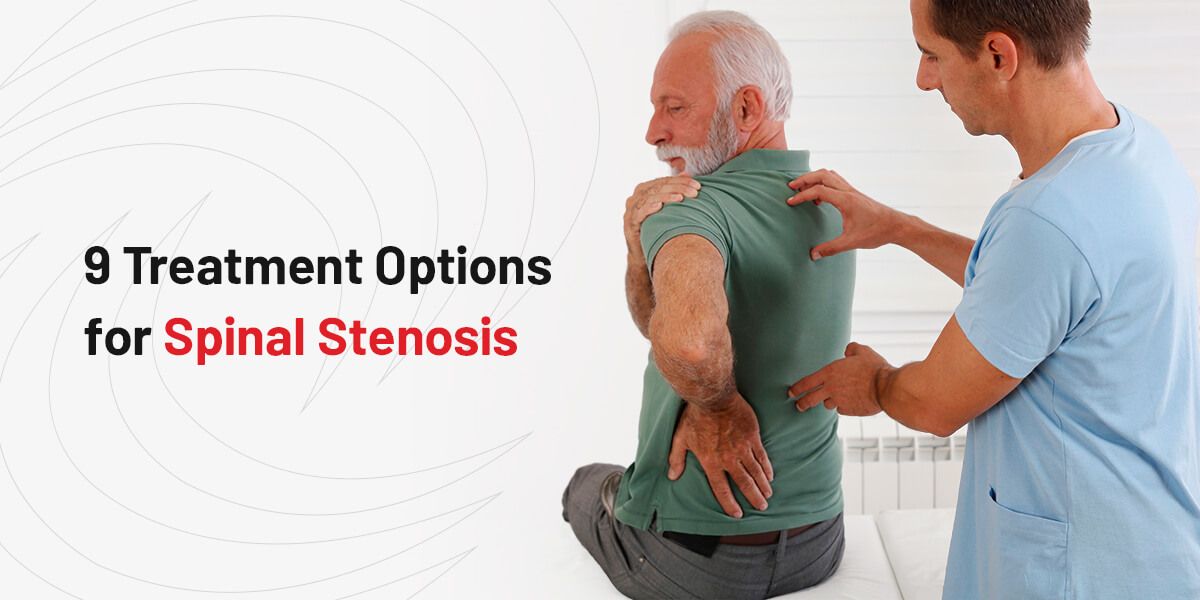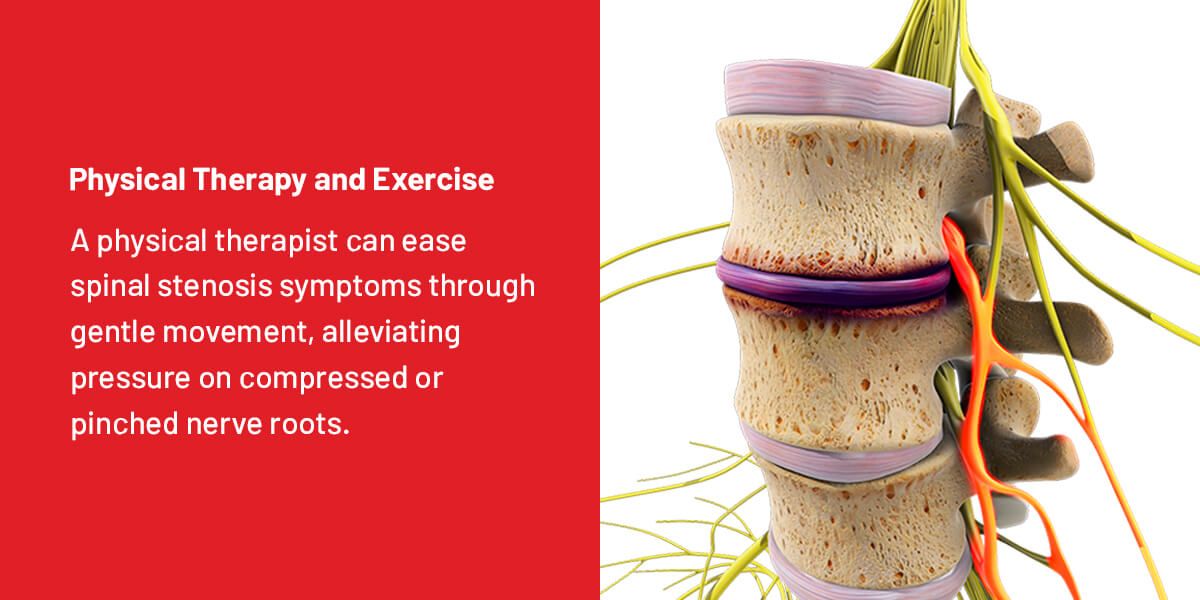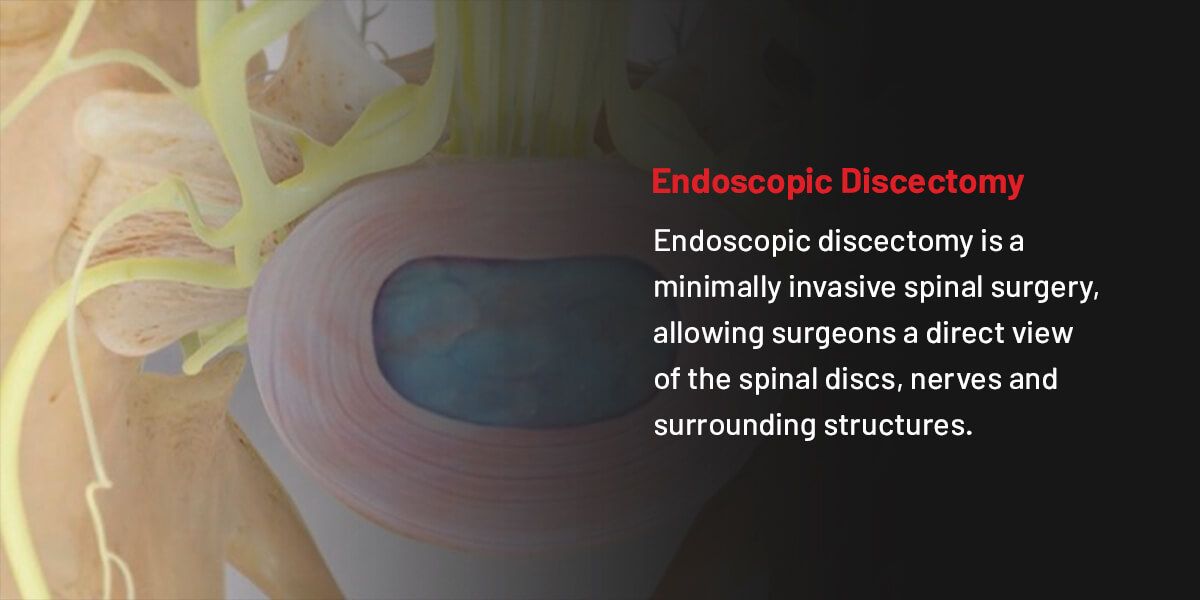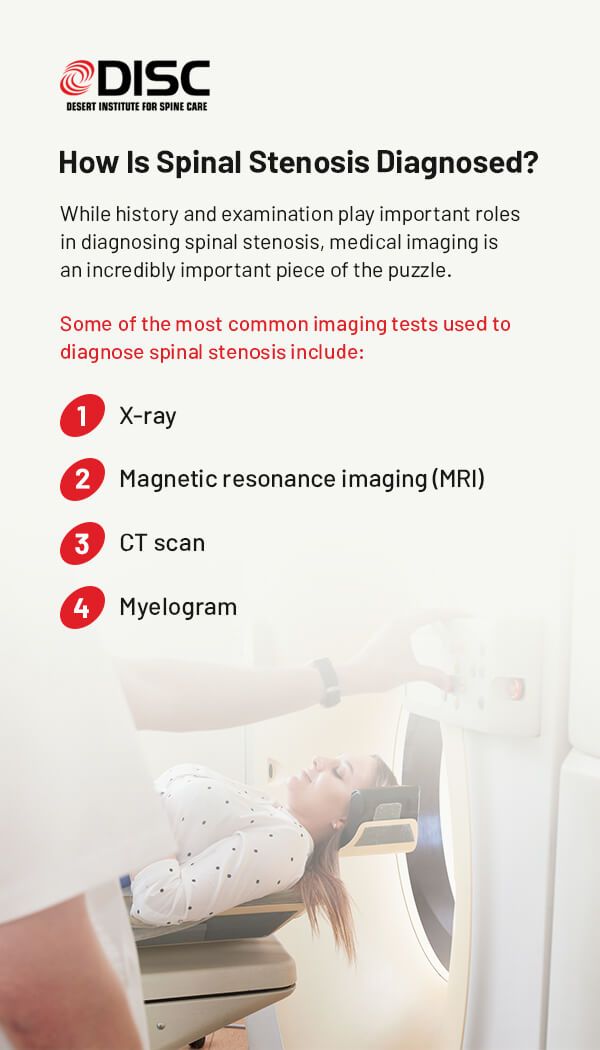
Spinal stenosis is when the spaces within the spinal column narrow, leading to spinal nerve and cord compression. While stenosis can develop anywhere within the spinal column, it is most common in the lumbar spine in the lower back and the cervical spine in the neck.
While some patients may not display noticeable symptoms with spinal stenosis, others often experience pain, discomfort and limited mobility. Muscle weakness, numbness and tingling are also common symptoms of spinal stenosis. Learn how to treat spinal stenosis with nine innovative treatments.
Non-surgical spinal stenosis treatments can provide adequate relief from spinal stenosis symptoms, including pain and stiffness. In most cases, spinal specialists suggest a non-surgical spinal stenosis treatment to see if patients experience relief from symptoms without the need for invasive surgery.
Research indicates roughly 250,000 to 500,000 people in the United States display symptoms of spinal stenosis. As medical technology improves, new treatments for spinal stenosis will become available to manage symptoms. Learn how to treat spinal stenosis without surgery with these treatments:
Medication is a common spinal canal stenosis treatment that can alleviate pain and discomfort. Medication is an effective spinal stenosis treatment split into two broad categories — over-the-counter and prescription medication. Some of the most common over-the-counter medications for spinal stenosis include non-steroidal anti-inflammatory drugs (NSAIDs) and analgesics.
Many physicians recommend acetaminophen, which provides pain relief through the central nervous system. While acetaminophen is available over-the-counter, it is also available in prescription strength. Common NSAIDs that can ease pain and inflammation include celecoxib, naproxen, ibuprofen and aspirin.
While over-the-counter medication can minimize painful symptoms, some patients may require prescription-strength medication. In some cases, a doctor may even recommend opioid medication for severe pain, including nerve-related pain. Although opioids provide a high level of pain relief, patients can only take these types of medication for a certain period of time, as they aren’t meant for long-term use.
Depending on your symptoms, spine specialists may recommend other prescription medication, such as nerve desensitizing medicine and muscle relaxers. Before starting any medication, even over-the-counter medications, you should speak with a spine specialist.
Some spinal symptoms require specific medication for the most effective management of pain or discomfort. Combining certain medications can also have a negative effect and worsen pain or cause unpleasant side effects. A spinal specialist can help you determine which spinal stenosis medication is right for you.

Physical therapy is another important component of treating spinal stenosis and improving pain, stiffness and inflammation. Almost all spinal stenosis treatments involve guided exercises and physical therapy. While physical therapy, guided stretches and exercise aren’t a cure, they can strengthen weakened muscles and improve mobility.
With back pain, it is common that many muscles weaken because of inactivity or decreased use. A physical therapist can ease spinal stenosis symptoms through gentle movement, alleviating pressure on compressed or pinched nerve roots. Range-of-motion exercises can also stabilize the joints and improve muscle health, improving a person’s range of motion and mobility.
A physical therapist will also teach patients aerobic exercises, helping improve tolerance for specific activities that may have been negatively impacted by spinal stenosis symptoms. Physical therapy can also prepare patients to manage pain at home and minimize the risk of future back pain episodes.
Epidural steroids injections (ESI) are a minimally invasive treatment option for spinal stenosis to alleviate pain and discomfort from spinal stenosis. An ESI combines corticosteroid medication for pain relief with a numbing agent to ensure comfort during administration.
A spinal specialist administers these drugs into the spine’s epidural space, the area between the protective sac surrounding the spinal cord and nerves and the spinal bones (vertebrae). An ESI can minimize inflammation and directly deliver pain-relieving medication to the affected spinal area.
An ESI can also help determine if you may need further treatment or spinal surgery to address spinal stenosis symptoms. In some cases, spinal stenosis can inhibit or prevent you from partaking in physical therapy. An ESI can minimize pain, allowing you to actively participate in physical therapy and strengthen the spine.
Physical therapy can be just as effective as surgical intervention for some symptoms and certain types of lower back pain. A physical therapist will focus on core strengthening exercises to treat symptoms during physical therapy. In many cases of spinal stenosis, the abdominal muscles are inactive and weakened, meaning they can’t support the lower spine as effectively.
Certain exercises can activate the core muscles, including the hips, abdomen, lower back and pelvis. Core exercises can also help stabilize the spine, preventing excess movement and compression. As you gain more strength and stabilize the spine, your physical therapist will add progressive exercises, providing a challenge to facilitate progress.
The facet joints are joints on each side of the mid-spine. A facet nerve block, also known as a selective nerve root block, is a treatment where a needle is placed into the facet joint. Physicians administer a facet nerve block using imaging guidance to inject a local anesthetic and steroid.
A physician may place a facet nerve block at one or several levels on either side of the spine, depending on your symptoms. A facet block is often used as a diagnostic test to determine the exact source of spinal pain. Painful areas of the spine will respond to the injected medication.
While a facet nerve block is a useful diagnostic tool, it can be useful to treat various symptoms related to spinal stenosis. Following a facet nerve block, the pain medicine may take between 24 to 72 hours to take effect. A facet nerve block can improve symptoms for a few weeks to months, depending on individual symptoms.
While we may not think about it, our daily posture directly affects our spinal health. Poor posture can also worsen pain and symptoms from an underlying medical condition. A healthy posture can promote proper spine health and minimize pain and discomfort.
Poor posture can place additional strain and stress on the spine, aggravating sore areas affected by spinal stenosis. Although it is important to pay attention to our posture while standing or sitting, our posture at rest, such as lying down, also affects our spinal health.
Poor posture, including slumping and slouching, can cause spinal misalignment, degradation and limited mobility. Gradual wear and tear on the spine cause the spine to become more fragile and prone to injury or chronic back conditions. In some cases, poor posture can make it difficult to breathe or negatively impact your digestive system.
In some cases, non-surgical treatments may not be enough to relieve spinal stenosis symptoms. If symptoms don’t improve with non-surgical modalities, a spinal surgeon may suggest surgery as a treatment for severe spinal stenosis. Spinal stenosis surgery is often recommended if spinal stenosis causes extreme pain or progressive neurological symptoms, including weakness and numbness.
Before considering spinal surgery, physicians typically recommend a few weeks to a couple of months of various non-surgical treatments before surgery. Fortunately, spinal stenosis is an effective treatment, with approximately 80% to 90% of patients experiencing pain relief following surgery. Some of the most common spinal surgeries for stenosis include:
Lumbar laminectomy, sometimes referred to as open decompression, is a stenosis procedure that can cause spinal canal narrowing. During a laminectomy, a spinal surgeon removes a portion or all of the lamina, the posterior part of the vertebra, allowing for more space to alleviate compression on the nerve roots and spinal cord.
Spinal stenosis in the lumbar region of the spine can compress the spinal cord, cauda equina, spinal dura and thecal sac. In some cases, a combination or all of these structures are affected. When one or all of these structures experience compression, leg pain can occur.
The main goal of a laminectomy is to alleviate this pressure that causes back pain. A laminectomy can also improve leg function, minimizing leg pain, stiffness and discomfort, leading to a decreased range of motion and mobility. In some cases, a laminectomy may be performed on one or more spinal levels, depending on the degree of symptoms.
Instead of removing the whole lamina, a laminotomy is a stenosis surgery that removes only a piece of the lamina, often by creating a small hole large enough to alleviate tension and compression in a specific part of the spine. During a laminotomy, a spinal surgeon directs the patient to lay face down on a spinal surgical table.
General anesthesia ensures the patient’s comfort and well-being during spinal surgery. The spinal surgeon can identify the exact source of painful stenosis symptoms with an X-ray. The surgeon places a small incision in the back.
The surgeon gently lifts the muscles — if an open spinal surgery — or uses a retractor — if a minimally invasive surgery — to access the spine. As the surgeon gains access to the spine, they can locate and remove a portion of the lamina to alleviate compression. A surgeon can decompress one or both sides to ensure the portion of the lamina causing compression is removed.
Cervical laminoplasty is another type of decompression spinal surgery designed to alleviate pressure on the spinal nerves and cord resulting from stenosis. Instead of removing the lamina, laminoplasty creates a hinge on one of the lamina’s sides, creating more space and relieving built-up spinal cord pressure.
If the spinal nerves are compressed by stenosis, you may experience radiculopathy, which is numbness, weakness or pain in a hand or arm. While spinal nerve compression causes negative symptoms, spinal cord pressure can cause even more significant complications.
Spinal cord compression can damage the spinal cord’s delicate soft tissues and may cause difficulty walking and pain or numbness in one or both legs. More severe cases of spinal cord compression can even impair bladder and bowel control, increasing the risk of incontinence.
Fortunately, creating a hinge on the affected lamina during laminoplasty can improve symptoms and minimize the risk of these negative complications.

Endoscopic discectomy is a minimally invasive spinal surgery, allowing surgeons a direct view of the spinal discs, nerves and surrounding structures. Generally, endoscopic discectomy is ideal for alleviating nerve root damage caused by compression.
Endoscopic discectomy involves removing a damaged or unhealthy portion of a spinal disc that may be causing or contributing to compression and irritation of nearby nerves. A discectomy is highly effective at improving pain that radiates down the legs or arms due to spinal nerve compression.

Spinal specialists consider several aspects of your health while considering what causes your symptoms. One of the most important aspects of a proper diagnosis is a firm understanding of a patient’s personal medical history and family history. During a discussion of the patient’s medical history, the physician can learn more about recent or current symptoms.
Physicians often perform a physical examination to feel the various portions of the spine and note where the pain originates. During this process, physicians record any symptoms related to limited mobility or a decreased range of motion.
While history and examination play important roles in diagnosing spinal stenosis, medical imaging is an incredibly important piece of the puzzle. Medical imaging is a useful diagnostic tool that provides physicians with in-depth information on your spinal health. Some of the most common imaging tests used to diagnose spinal stenosis include:
An X-ray can produce detailed spinal images that help physicians detect and diagnose diseases, injuries or other sources of spinal pain. Typically, X-rays are used to assess the health of the bones and joints and can help confirm cases of spinal stenosis.
An MRI is an imaging technique using computer-generated radio waves and a magnetic field to capture images of the body’s internal tissues and organs. MRIs are exceptionally beneficial when a physician needs to assess the nervous system. While a physician can use an MRI to diagnose spinal stenosis, it can also help a physician track treatment progress.
A CT scan stands for a computed tomography scan, which can also help diagnose spinal stenosis. CT scans use a combination of X-ray images taken at various angles to achieve cross-sectional images of the soft tissues, blood vessels and bones. CT scans provide a higher level of detail when compared to traditional X-rays.
A myelogram is an imaging test performed to help diagnose spinal stenosis. During a myelogram, a radiologist will use contrast dye and CT scans or X-rays to determine any unhealthy spinal sections. Before the procedure, a radiologist injects contrast dye into the spinal column, providing the radiologist with a clear view of the spinal structures.
The Desert Institute for Spine Care (DISC) is the premier destination for timely, accurate spinal diagnoses and prompt treatment. Our team of physicians and medical professionals are available to answer any questions you may have and are dedicated to helping each patient gain a higher quality of life by minimizing discomfort and pain.
We are experts at treating various spinal conditions, including herniated discs, vertebral compression fractures and failed back surgery syndrome. Our team can also diagnose and treat scoliosis, spinal bone spurs, disc tears, sciatica and more. Let us help you regain a pain-free life.